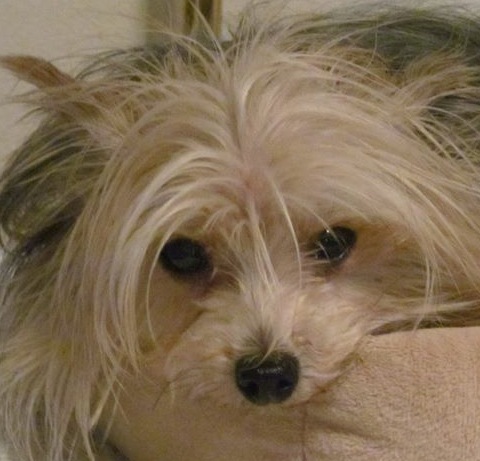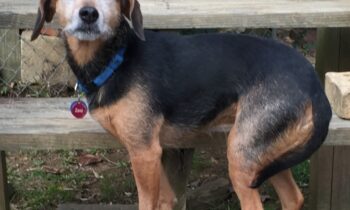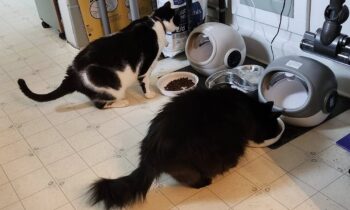
What have you decided to use as the spot you want your pet to go to instead of dashing out your open front door when it’s opened? Will your dog go to a crate, a bed, a rug or mat? Will your cat go to the top level of a cat tree? Did you decide instead that the “line” where the rug of the living room meets the tile of the foyer will be the boundary behind which your pet will wait?
Before you start to train your pet to go to that spot, you need to name and define it. You need a verbal cue—a word or short set of words—that will give your pet the “cue” to perform the behavior of going to the spot and waiting there calmly for further information. You need a full definition of the behavior or series of behaviors you will train.
In this case, you eventually expect the pet not only to go to the spot, but to lie down at that spot, and to stay down calmly until released.
When we say “go to the spot” or “lie down at that spot,” keep in mind that we need a complete picture of how that looks. Decide now, before you start training, how many paws you want “on the spot”—all four, three, just one or two? Imagine that you choose the least difficult of these choices: only one paw physically on the spot. Then think of how much closer to the open door your pet can reach with only one paw on the spot! You guess that four paws on the spot might be a better bet?
Whatever you decide for each behavior, remember that these definitions are important. If you’re unsure of your definition—especially if you’re having a hard time imagining what specifics might be needed—ask a friend or family member to help you by “being the pet,” acting out some alternatives that your pet might try, so you can better choose how to define what you want. Kids can be really good at “acting” like their family pet. Involve the whole family!
Let’s say that I have decided to use a non-slip rug-like mat for my dog’s “spot.” I’ve introduced it to the dog by leaving it out around the house so he’s become familiar with seeing it, and he isn’t particularly concerned about it in any way. I’ve encouraged him to think of the mat as a good thing.
I’ve decided that the behavior I want to train is called “Rug.” The description of “Rug” is:
- Goes quickly and quietly to rug
- Puts all four paws on rug
- Lies down on rug in comfortable position
- Stays calmly on rug until released
I train the completed “chain” of behaviors one behavior at a time. I add behaviors as my dog succeeds, going back to an easier step if he falters. I want a firm foundation, so I try not to go too fast. I am calm and I am patient.
I’ve already taught my dog the “Stay” cue in a “Down” position. In other words, he knows that he is rewarded for lying in a comfortable position (not up on his elbows, primed to leap away) until I release him. He stays in a Down while I turn my back. He stays in a Down while I walk out of sight. He stays in a Down with distractions, like someone passing by him or a treat dropped across the room. He stays in a Down on a variety of surfaces, inside and outside.
I am confident with his down-stay. I introduce the mat I use for the “Rug” behavior and cue him to Down on it. He does that willingly. I continue to work with him over several training sessions to be sure that Downing on the mat is not an issue for him. It isn’t. Then I work on a Stay in a Down position on the mat. Again, no problem, so I go through the steps of increasing distance and distractions. He’s perfectly comfortable with Down Stays on the mat, wherever the mat may be.

My next job is to teach the dog to go to the mat. I can train this phase without a clicker, but I know that a clicker makes it much easier for the dog. It’s time, therefore, for me to introduce the clicker—or, if the dog has worked with a clicker sometime in the past, to reintroduce the clicker to the dog as if he were hearing it for the first time.
The first step of this process is called “charging the clicker.” You need:
- A quiet, calm place to train, inside, with no distractions
- A hungry dog—one who’s eliminated recently
- A clicker
- A good supply of high-value treats that this dog loves
“Charging the clicker” means giving the dog a good impression of it: you want the dog to pair the sound of the clicker with an expectation of the immediate reward of high-value treats.
Click—treat!
You don’t need to be tidy about the treating part. You can throw a few on the floor or feed from your hand. Most important is that the treats are “delivered” to the dog immediately after the click—no delay. You can practice your coordination ahead of time without the dog, or have a human stand in for the dog with Cheerios or M&Ms for their treats. Once you’ve “delivered” the treat, it’s up to the dog. Give him a few moments to pursue the dropped treats. When he’s done, click-treat again. (If the dog shows no interest in eating them, reconsider your choice of treats. Try something else.)
“Charge the clicker” for a few minutes at a time only. Quit with the dog wanting more!
Do this exercise several times a day for several days. Ideally, you will see the dog start to get interested at the sight of a clicker in your hand. His doggy mind will be predicting treats—and that’s good!
Keep practicing your dog’s Down-Stays, too, in separate training sessions on those same days. Do both “charging the clicker” and Down-Stays on the mat in various locations through the week.
Next time I will explain how you will use the clicker to “shape” the dog’s behavior in tiny increments to get him from wherever he starts to the mat . . . by his own choice . . . with no forcing and no punishment!



